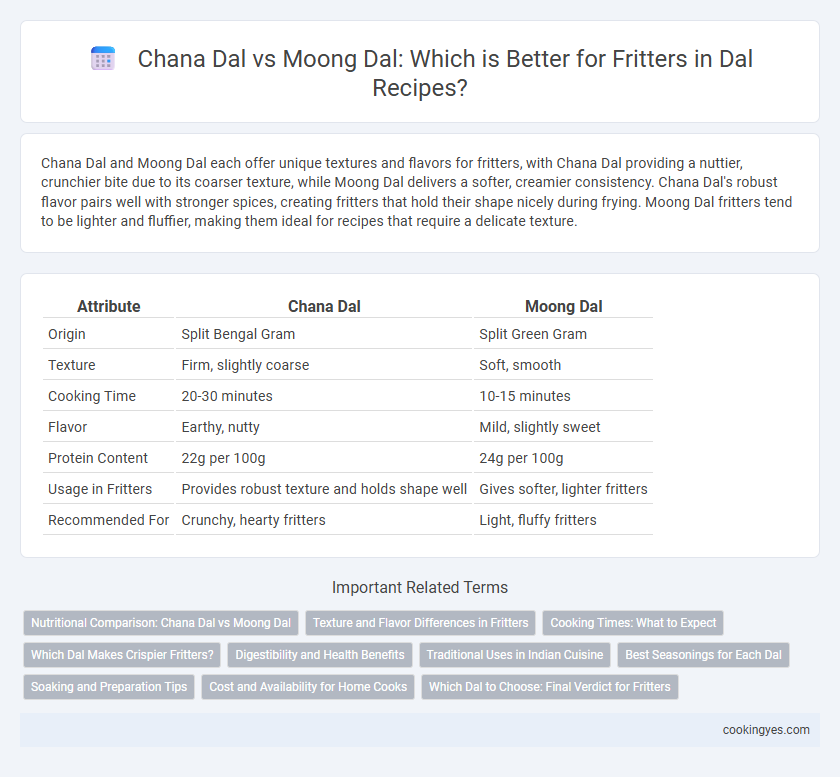Chana Dal and Moong Dal each offer unique textures and flavors for fritters, with Chana Dal providing a nuttier, crunchier bite due to its coarser texture, while Moong Dal delivers a softer, creamier consistency. Chana Dal's robust flavor pairs well with stronger spices, creating fritters that hold their shape nicely during frying. Moong Dal fritters tend to be lighter and fluffier, making them ideal for recipes that require a delicate texture.
Table of Comparison
| Attribute | Chana Dal | Moong Dal |
|---|---|---|
| Origin | Split Bengal Gram | Split Green Gram |
| Texture | Firm, slightly coarse | Soft, smooth |
| Cooking Time | 20-30 minutes | 10-15 minutes |
| Flavor | Earthy, nutty | Mild, slightly sweet |
| Protein Content | 22g per 100g | 24g per 100g |
| Usage in Fritters | Provides robust texture and holds shape well | Gives softer, lighter fritters |
| Recommended For | Crunchy, hearty fritters | Light, fluffy fritters |
Nutritional Comparison: Chana Dal vs Moong Dal
Chana Dal contains higher protein and fiber content, contributing to better satiety and digestive health in fritters compared to Moong Dal. Moong Dal offers a lower calorie count and is richer in vitamin C and antioxidants, promoting immune support and reducing oxidative stress. Choosing between Chana Dal and Moong Dal for fritters depends on whether the priority is protein and fiber intake or calorie control and vitamin enhancement.
Texture and Flavor Differences in Fritters
Chana Dal fritters offer a dense, slightly coarse texture with a nutty flavor that holds shape well during frying, providing a hearty bite. Moong Dal fritters are lighter and softer, with a mild, subtly sweet taste resulting in a fluffier and more delicate fritter. The choice between them hinges on desired texture: Chana Dal for a robust, crunchy fritter and Moong Dal for a tender, airy outcome.
Cooking Times: What to Expect
Chana Dal typically requires a longer soaking and cooking time, around 30 to 45 minutes when boiled, making it ideal for fritters that need a firmer texture. Moong Dal cooks faster, often within 20 to 30 minutes, providing a softer consistency that binds well but may yield lighter, less crispy fritters. Understanding these cooking times helps achieve the desired fritter texture and flavor intensity.
Which Dal Makes Crispier Fritters?
Chana dal produces crispier fritters compared to moong dal due to its coarser texture and higher starch content, which helps create a firm, crunchy exterior when fried. Moong dal yields softer fritters with a lighter, more delicate bite, making it less ideal for achieving maximum crispiness. For perfectly crispy fritters, chana dal remains the preferred choice among chefs and home cooks alike.
Digestibility and Health Benefits
Chana Dal is rich in protein and fiber, making it highly digestible and effective for digestive health, while also promoting satiety and blood sugar regulation. Moong Dal, known for its lightness and easy digestibility, contains antioxidants and essential nutrients that support heart health and reduce inflammation. Both dals offer unique health benefits, but Moong Dal is often preferred for fritters due to its smoother texture and gentler impact on digestion.
Traditional Uses in Indian Cuisine
Chana Dal, made from split chickpeas, is traditionally preferred for Indian fritters due to its robust texture and nutty flavor, which holds well during frying. Moong Dal, derived from split mung beans, offers a lighter, softer consistency, often used in fritters requiring a tender bite and quicker cooking time. Both dals are integral in regional Indian recipes, with Chana Dal favored in North Indian pakoras and Moong Dal popular in South Indian and street food variations.
Best Seasonings for Each Dal
Chana dal fritters benefit from robust spices like cumin, coriander, and turmeric to enhance their earthy, nutty flavor, while a touch of ginger and garlic adds depth. Moong dal fritters pair exceptionally well with lighter seasonings such as fresh curry leaves, green chilies, and a sprinkle of asafoetida to complement their mild, slightly sweet taste. Both dals can be balanced with salt and black pepper, but chana dal's dense texture calls for bolder seasonings compared to moong dal's delicate profile.
Soaking and Preparation Tips
Chana Dal requires a longer soaking time of about 4 to 6 hours to soften and ensure even cooking, while Moong Dal needs only 2 to 3 hours due to its smaller size and quicker hydration. For fritters, draining excess water thoroughly after soaking both dals is crucial to achieve a crispy texture without sogginess. Blending soaked dals with minimal water helps maintain batter consistency, enhancing the fritters' crunch and flavor.
Cost and Availability for Home Cooks
Chana Dal is generally more affordable and widely available in most grocery stores, making it a cost-effective choice for home cooks preparing fritters. Moong Dal, while slightly pricier, offers a softer texture but may be less accessible in certain regions. For budget-conscious cooks seeking easy-to-find ingredients, Chana Dal remains the preferred option.
Which Dal to Choose: Final Verdict for Fritters
Chana Dal offers a firmer texture and nutty flavor, making it ideal for crispy, hearty fritters that hold their shape well during frying. Moong Dal imparts a softer, creamier consistency, resulting in lighter, fluffier fritters that cook quickly but may be more delicate. Choose Chana Dal for sturdier fritters with a robust bite, while Moong Dal suits those preferring tender, melt-in-mouth fritters.
Chana Dal vs Moong Dal for Fritters Infographic

 cookingyes.com
cookingyes.com